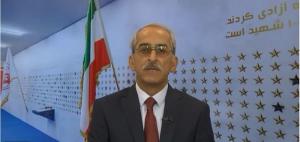(Video) The 1988 Massacre of Political Prisoners in Iran: Eyewitness Accounts, Mohammad Reza Zand

(PMOI / MEK Iran) and (NCRI): Mohammad Reza Zand was a student and arrested on July 28, 1981, for supporting the Mojahedin-e-Khalq, MEK. He spent 11 years in Evin, Ghezelhesar, and Gohardasht prisons.

(PMOI / MEK Iran) and (NCRI): The 1988 massacre did not just happen. It was rooted in a fundamental conflict between the people of Iran, demanding freedom, democracy, and economic and social development after the overthrow of the Shah.

(PMOI / MEK Iran) and (NCRI): The authorities had already paved the way to massacre all the prisoners defending the Mojahedin-e-Khalq, MEK, and their causes. One day, Mortazavi came into the ward, and the prisoners asked him to resolve a series of issues and problems.

(PMOI / MEK Iran) and (NCRI): In July 1988, Ruhollah Khomeini, issued a decree, stating that all the political prisoners who remain steadfast in their support for the Iranian opposition movement, the People’s Mojahedin Organization of Iran.

(PMOI / MEK Iran) and (NCRI): Upon Khomeini’s fatwa, ‘Death Commissions‘ were formed in Tehran and across Iran. The prisoners were brought before the Commission, and their fates were decided in a few minutes.

(PMOI / MEK Iran) and (NCRI): “We urge the international community to recognize the massacre of 30,000 political prisoners in 1988 as genocide and a crime against humanity,”
Raisi is someone who according to international human rights organizations, including Amnesty International, must be tried for crimes against humanity.
Eyewitness Mohammad Reza Zand
My name is Mohammad Reza Zand. I was a student and arrested on July 28, 1981, for supporting the Mojahedin-e-Khalq, MEK. I spent 11 years in Evin, Ghezelhesar, and Gohardasht prisons. During the 1988 massacre of 30,000 political prisoners, 90% of whom were members and supporters of the MEK, I was at Gohardasht Prison. I have to provide an explanation here. When we say 30,000 and the MEK, we are talking about Khomeini’s religious decree against all MEK who insisted on their position and used the term Mojahed, MEK.
The term Mojahed precisely meant freedom for the people and secondly gaining the trust of the people. Over the years, the Iranian people had seen a lot of betrayals. But this time, the MEK decided to sacrifice everything they have to regain the trust of the people who had been particularly betrayed by Khomeini during the 1979 revolution.
That is how these 30,000 people stood up for their position in defense of the name MEK. Of course, the crime that was committed, and I witnessed it, I can talk about a small portion of it in Gohardasht Prison.
It was July 28, 1988, when we had gathered in protest of the suspension of delivery of newspapers. An IRGC guard came and took me and 10-11 other people away. They took us out and started beating us. There, my rib and one of my toes were broken. Others were also severely beaten. They asked us what our charge is. And we said supporting the MEK. They sent us inside and said that we’ll come back on Saturday. This was on Thursday, July 28, 1988, at night.
I should also say that during a year-long period, we and other prisoners were taken and asked about charges and the length of the terms. A categorization was taking place. Prisoners were taken away, like those with life sentences. Transfers were taking place. In these transfers, for example, they had told Massoud Moqbeli that we are going to seal your fate. So, we were expecting something, but that was it.
That night passed. On Saturday morning, July 30, at around 8 or 9 in the morning, I and others, including my brother Reza Zand, were sitting in the ward hall. An IRGC guard came and read out about 20 names. They read out my brother’s name instead of mine. My brother had a rosary and a ring. He gave them to me and said to keep these as souvenirs.
I became anxious and said why? Keep them yourself. I was speculating that they would take him to solitary confinement because of the protest that we had carried out. He said that I don’t know why I feel this way but I don’t think we’re going to see each other again. Sometime before that, when he had seen our mother, he had repeated the exact same thing.
I didn’t accept his souvenirs. Another friend kept them, and Reza left. After they took them, we lost contact with them. Of course, something would happen that strengthened our suspicion that executions were taking place. On August 4, through Morse Code, we communicated with Dariush Hanifeh Pour Ziba. They had not taken him for executions yet. We found out this way that the executions had begun, and he said that the regime is conducting a massacre against everyone. Dariush, of course, was martyred himself and remained committed to his vow.
It was August 6 … On August 4, the entire ward that we were in was emptied. We were taken to rooms called “Darbasteh” until August 6, when they read out our names and took us to the Death Committee. We used to sit in the Death Corridor in front of the room where the Death Committee was. The Death Committee included Hossein-Ali Nayyeri, the chief of the committee, Mostafa Pourmohammadi, the deputy Intelligence Minister representative, Eshraqi, and Ebrahim Raisi, who represented the deputy prosecutor. This was the four-member committee. Now, some days it was three of them, some days four. But this committee, whether in Gohardasht or Evin, was consisted of these four people.
When they took me to the Death Committee, Mohammad Mir Moqisseh took me there, who was the prison warden under the pseudonym Nasserian. He was also the deputy prosecutor. Before sitting on the chair and removing my blindfold, he said that we have executed your brother, and if you don’t accept our terms, we will execute you too. I was shocked. Then, Nayyeri asked me to do you know why you’re here? I immediately asked why did you execute my brother? He was serving a 10-year sentence and had completed seven years of it. Nayyeri changed the subject and said what is your position yourself? I said I don’t have an opinion, answer my question.
At any rate, they sent me out. We were sitting there, when I saw a number of other friends were taken there, including Nasser Mansouri, whose spinal cord was injured. They wanted him to expose the activists’ organization in prison and he had refused. So, he had thrown himself off the second floor and his back was broken. He was taken there on a stretcher. He was taken to the Death Committee on the same stretcher and then taken to be executed.
There, I saw Hamid Noury, who was the chief of staff of Nasserian; his name was Hamid Abbasi. Davoud Lashkari was in charge of prison security. I saw that Hamid Noury and him coming from the end of the hall, which we later found out led to the Hosseynieh or the place of executions, with a bunch of blindfolds in his hands. After he returned, Lashkari went and Hamid Noury read out names, and they would not read the entire name but only the first name and the name of the father, so that no one would find out what’s going on.
After some people went, including Mahmoud Zaki, I asked him what did you say? He said I told them I am a member of the MEK. Mahmoud was taken and executed. The executions had started on July 30. The first group that was executed included those who had been transferred there from Mashhad Prison. They had all defended the MEK. All of them had said that we would defend the MEK and Massoud and Maryam Rajavi. The majority of the prisoners would say we are MEK or they would stress that we are members of the Massoud Rajavi organization. The executions happened on this basis and nothing else.
The position of a MEK member would equal execution. Mojahed, as I said, was synonymous with two other words, including freedom for the Iranian people, and secondly gaining the trust of the people betrayed by Khomeini during the 1979 revolution. Someone had to treat this wound once and for all, by paying the price for it, which was the blood of 30,000 MEK members. This price was paid.
At any rate, this Death Committee executed thousands of people in Evin and Gohardasht prisons. In other prisons, other Death Committees did the same. Today, Raisi has become the regime’s president. This was someone who according to international human rights organizations, including Amnesty International, must be tried for crimes against humanity.
That is why I hope one day the people of Iran can witness the trial and punishment of all the perpetrators and decision-makers of the 1988 massacre and all the regime’s mass murders against the MEK over the past 40 years. I hope that in particular Khamenei and Raisi would be put on trial soon.
Shahin Gobadi
NCRI
+33 6 51 65 32 31
email us here
Visit us on social media:
Facebook
Twitter
The 1988 Massacre of Political Prisoners in Iran: Eyewitness Accounts, Mohammad Zand
Legal Disclaimer:
EIN Presswire provides this news content "as is" without warranty of any kind. We do not accept any responsibility or liability for the accuracy, content, images, videos, licenses, completeness, legality, or reliability of the information contained in this article. If you have any complaints or copyright issues related to this article, kindly contact the author above.


